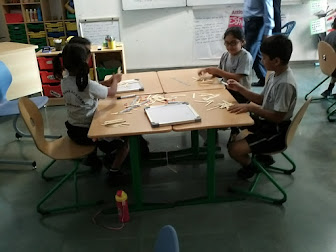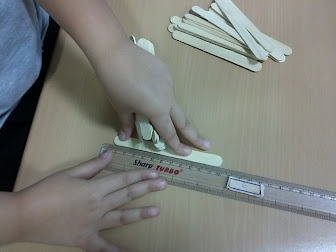Something interesting happened the other day in my maths class. We had started a new topic, Division.
 I asked the students to turn on their laptops and talk about their understanding of division. They loved watching themselves talk. Some even put on an accent in order to sound posh! :) Watching the videos, it was clear that some students had a fair understanding of what division was, while other students had no clue. One student said multiplication is division. Another student said it is like division. Then as the lesson progressed, this slowly changed to- it is connected to division, and finally, one very shy and quiet student exclaimed that it was inversely related to division. Bingo! She had made a connection to the concept of "inversion."
I asked the students to turn on their laptops and talk about their understanding of division. They loved watching themselves talk. Some even put on an accent in order to sound posh! :) Watching the videos, it was clear that some students had a fair understanding of what division was, while other students had no clue. One student said multiplication is division. Another student said it is like division. Then as the lesson progressed, this slowly changed to- it is connected to division, and finally, one very shy and quiet student exclaimed that it was inversely related to division. Bingo! She had made a connection to the concept of "inversion."
As this was a completely new topic in grade 3, the students started warming up to it using ice cream sticks, which we had in plenty. I asked them to grab a handful and share them equally amongst themselves. It was interesting to observe how different students shared them. Some dealt them like cards while others grabbed them in twos or threes and started distributing them.
At one point I asked them to take a number of stick which will result in there being a remainder. One child said it cant be done as the number was odd! Loved this moment as she showed conceptual understanding :)
Some kids were not fazed and decided to split the stick. I took the opportunity to talk about how to split it in exactly half. Here is a shot of a student measuring it in the wrong way. It allowed for a quick recapitulation of where to place an object when measuring it. I noted 3 students doing this and have made a mental note to visit them again in the future to check on their learning.
It was a crisp bright Saturday morning when I went out for my walk. The sun was an an orange floating on a blue bed of emptiness. I was chatting about my class to a colleague as our feet scrunched on the red gravel.
"Is Mr D's daughter in your class?" my companion asked me.
"Yes. Why?"
" Oh my!...She went on explaining the concept of division to her dad. She spent almost half an hour talking about division!"
 I asked the students to turn on their laptops and talk about their understanding of division. They loved watching themselves talk. Some even put on an accent in order to sound posh! :) Watching the videos, it was clear that some students had a fair understanding of what division was, while other students had no clue. One student said multiplication is division. Another student said it is like division. Then as the lesson progressed, this slowly changed to- it is connected to division, and finally, one very shy and quiet student exclaimed that it was inversely related to division. Bingo! She had made a connection to the concept of "inversion."
I asked the students to turn on their laptops and talk about their understanding of division. They loved watching themselves talk. Some even put on an accent in order to sound posh! :) Watching the videos, it was clear that some students had a fair understanding of what division was, while other students had no clue. One student said multiplication is division. Another student said it is like division. Then as the lesson progressed, this slowly changed to- it is connected to division, and finally, one very shy and quiet student exclaimed that it was inversely related to division. Bingo! She had made a connection to the concept of "inversion." As this was a completely new topic in grade 3, the students started warming up to it using ice cream sticks, which we had in plenty. I asked them to grab a handful and share them equally amongst themselves. It was interesting to observe how different students shared them. Some dealt them like cards while others grabbed them in twos or threes and started distributing them.
At one point I asked them to take a number of stick which will result in there being a remainder. One child said it cant be done as the number was odd! Loved this moment as she showed conceptual understanding :)
Some kids were not fazed and decided to split the stick. I took the opportunity to talk about how to split it in exactly half. Here is a shot of a student measuring it in the wrong way. It allowed for a quick recapitulation of where to place an object when measuring it. I noted 3 students doing this and have made a mental note to visit them again in the future to check on their learning.
 |
| Placing the object ion the wrong place- a mistake students often make! |
Once they had the got the concept of sharing equally, I looked at the board which had the words "Learning Objective" written on it. "What do you think, the learning objective could be, students?"
Division means sharing equally? And finally one student said, "Just like multiplication is repeated addition, division is repeated subtraction!" It seemed these students were ready to move on! I wasn't wrong.
The next day, a student brought packets of popcorn to distribute to the whole school. There were 149 packets of popcorn. I asked them, if this student to change his mind and decide to share the pop corns amongst the students in 3K (there are 12 students), how much would each of them get? The students rushed to get their white boards and started working on it. I reminded them of one fact, 12 X 10 = 120.
Surprisingly, the students are able to divided 3 digit by 2 digit numbers on the second day of division. I am aware that we need to start small and then build on their knowledge and work towards bigger numbers. But who says it is the only way? If the conceptual understanding is solid, what is stopping the students from learning?
It was a crisp bright Saturday morning when I went out for my walk. The sun was an an orange floating on a blue bed of emptiness. I was chatting about my class to a colleague as our feet scrunched on the red gravel.
"Is Mr D's daughter in your class?" my companion asked me.
"Yes. Why?"
" Oh my!...She went on explaining the concept of division to her dad. She spent almost half an hour talking about division!"
Comments
Post a Comment
Thank you for taking the time to read my blog.